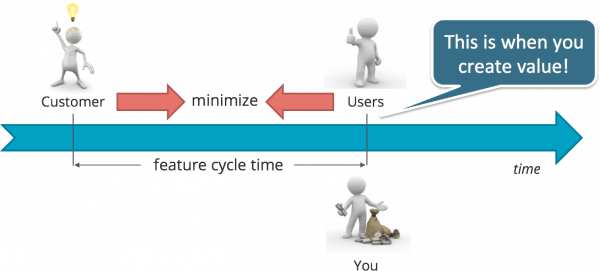The software can be deployed either manually or automatically. Manual deployment requires a team involvement at each and every stage of the software delivery process. Automatic deployment uses technology that enables to automatically release products to various environments.
Solutions that automate your deployment processes improve the productivity of both the Dev and Ops teams. It enables them and the business to develop faster, accomplish more, and ultimately build better software. Software that can function more reliably for the end-user. Considering continuous deployment as an extension to continuous integration, it can minimize the lead time.
Why aren’t teams adopting it?
Software deployment automation is considered to be “no-barrier” then why aren’t more teams adopting this? Development teams hesitate or don’t show much interest because they feel that the overhead of creating, setting-up, configuring and maintaining an automated deployment mechanism to not be worth the potential short-term benefits.
Below are some of the misconceptions that people have regarding automatic deployments:
“Setting-up automatic deployment will take a lot of time! It’ll waste developers time, which can be used to create more software functionalities!”
“The deployment process of our software has so many variable things, how should we begin to automate it?”
“It’ll result into energy drain of the developers – who can rather be solving business problems instead of writing some scripts for automation.”
To overcome these misconceptions, one should be aware of the benefits of the auto deployments. So, without further delay, here are the 5 big benefits of deployment automation that teams should consider before parking the idea of automation.

The 5 Benefits of Automatic Deployments
1: Error free deployments
Manual deployments are prone to many errors. The reason is the involvement of humans intervention in this process. Important steps in a release cycle can miss accidentally, faults may not be spotted that occur during a release, the incorrect versions of software can be shipped, and broken software ends up going live. If you are lucky, you’ll be able to recover quickly, but things can go another way around as well.
Automatic deployment script need not be configured again and again. Once the auto-deployment pipeline is configured, the process will remain the same every time a release is triggered. If it works without any failure the first time you deploy your software into a given environment, it’ll work the 500th time as well.
2: Anyone can deploy software
Generally, performing manual or partially-automated deployments are often the responsibility of a small set of people in a company. Sometimes it’s very common that a single individual is responsible for all the deployment and delivery related chores of an organization. If by any chance that person is not available or is on leave, then the complete work is stuck, and it’s very difficult for someone else to do the deployment. But by automatic deployments, anyone who has access to the Deploy button can trigger a release.
3: Engineers spend their time developing software
Performing and validating a manual deployment process is often a time-consuming and thankless task. Sometimes developers have to spend their time on checking the deployment failure, but that time can be used for creating more interesting features and improving the software.
It takes only a few seconds to trigger a fully automated deployment. Human intervention is only required when there is some failure in the pipeline, and thus the developers time can be saved and utilized on tasks which are more important for them.
4: Easy deployments
Automated deployments are easily configurable and repeatable as well. Although the basic release process is fixed, the target environments and machines can be changed easily. This means that if software needs to be deployed to a new test environment or there is some new client installation coming up, the overhead of deploying to the new target is very meager.
5: Frequent releases
Frequent releases promote truly agile software development. Teams that release frequently can deliver valuable features to their users more often and in incremental steps. In doing so, they can get continuous feedback from these users on the software they are creating and adapt their approach as a result.
Deployment Automation in the Continuous Delivery Deployment Pipeline
In general, the process is triggered whenever a developer commits code to a software repository inside the version control system, such as Subversion or Git. Only when a build passes all stages, it is regarded to be of sufficient quality to be released into production.
Stage 1: Commit Stage
In the commit stage, the build automation server checks out the software repository into a temporary directory compiles the code and executes any quick running, environment agnostic tests. After that, release artifacts such as installer packages are assembled and documentation is generated.
Stage 2: Acceptance Test Stage
In the acceptance test stage, deployment automation scripts (executable application runtime environmental specifications) are executed to create an environment that is dedicated to the remainder of this stage and that is highly similar, not necessarily identical, to the production environment.
Stage 3: Capacity Test Stage
Similar to stage two, but automated capacity tests, typically load tests, are run to verify that the system can serve a defined level of service under production-like load conditions. Here, it is assessed whether the application is fit, mostly in regard to response time and throughput.
Stage 4: User Acceptance Test Stage
In this stage, the customer performs manual user acceptance tests as a final verification step.
Stage 5: Release Stage
After passing all the previous stages, a successful build is made available in a binary repository, such as an Artifactory, from where it can be released into production whenever the business is ready: in Continuous Delivery, as opposed to Continuous Deployment, releasing a build into production is still a semi-automatic process that should require you to do exactly two things: select a build from a list and press the release button.


